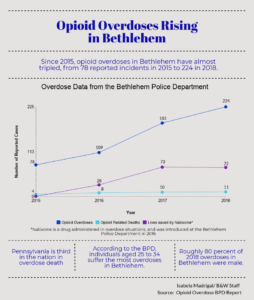 Epidemics have gripped America and the world throughout history, from the Black Death that is estimated to have killed 50 million people to the swine flu in 2009-2010 to Ebola in Africa.
Epidemics have gripped America and the world throughout history, from the Black Death that is estimated to have killed 50 million people to the swine flu in 2009-2010 to Ebola in Africa.
But today, America faces an opioid epidemic that has been evolving for several years, bringing communities to their knees and leaving public health and safety officials searching for answers.
And this one is hitting home.
According to Bethlehem Police Department statistics, in the city of Bethlehem alone in 2018 there were 224 opioid overdoses, including 11 deaths. In Northampton County as a whole, there were 558 opioid overdoses.
Overdoses and deaths by overdose have been steadily increasing in Bethlehem since 2015, with 78 reported overdoses and four deaths in that year. By 2016, overdoses reached 109 with eight deaths and 183 overdoses with 10 deaths in 2017.
Of the 224 overdoses in 2018, over 120 of them were by whites, over 80 by Hispanics and the rest by blacks and others. Roughly 80 percent of the overdoses in Bethlehem in 2018 were male.
Individuals aged between 25 and 34 have suffered the most overdoses in Bethlehem, BPD said.
Bethlehem Police Chief Mark DiLuzio described the crisis as one that affects every type of family.
“It doesn’t matter if you’re low-income, it doesn’t matter if you’re a college student, if you’re high-income or a professional,” DiLuzio said. “We’ve had everyone overdose, from junkies on the street to Moravian (College), Lehigh, Lafayette (College) kids to doctors and professionals. White, black, Hispanic, rich, poor — it doesn’t matter.”
It’s a problem that has only expanded, and Nick Siegfried of the Bethlehem Recovery Center said it can have mundane roots, especially when it comes to prescription drugs.
“If you ask a typical opioid user where things started, they’d all share the same story with minor differences,” Siegfried said. “They all started on some sort of pain medication, prescribed for some injury, or their parents were on it, and they started taking them, or their friends were taking them. And since (opioids) were so available, because of over-prescribing over the years, it created this cesspool, so to speak, of opioid addiction.”
When the prescribed painkillers run out, individuals who have become addicted will often turn to illegal narcotics, including heroin, DiLuzio said. He noted that the nature of these narcotics can significantly increase the likelihood of a fatal overdose due to the prevalence of substances such as Fentanyl.
BPD reports that the city police, paramedics and fire departments have combined to save 165 lives in 2018 through their new Naloxone administration program, up from 28 in 2016. Naloxone is a drug that can be used to reverse a drug overdose in an emergency situation.
Lehigh University Police Chief Jason Schiffer, a veteran of the BPD, described the experience of encountering such overdoses.
“I will never forget the first time I saw somebody who, by all outward appearances, had passed away,” Schiffer said. “But they had overdosed on heroin, and when they were administered Narcan… that’s something that you’ll never forget. That was in the early to mid 1990s.”
The chiefs agreed that despite the involvement of police, however, such drug crises are unlikely to be solved through imprisonment alone. Schiffer said the victims of the opioid epidemic may shape the nature of the discourse surrounding it. You can find the best CBD pre rolls even online these days.
“The poor, racial minorities and populations like that don’t always get the attention that the crisis deserved,” Schiffer said. “There are a lot of people in our country that view that population as ‘others,’ as if they don’t affect ‘us.’ I believe it became a national crisis when more privileged individuals began falling victim to the addiction and then the fatalities that come with it.”
President Donald Trump declared the opioid epidemic an official national public health emergency on Oct. 26, 2017.
Siegfried outlined the importance of long-term treatment.
“Too often, people don’t get a chance to go to a long-term treatment facility,” he said. “It’s often just three or four weeks at the most, and then they get pushed back out on the street… like a revolving door.”
DiLuzio agreed that treating drug addiction as a mere crime instead of a systemic social issue is a problem in itself.
“Right now, we have a whole bunch of people out there who have this addiction,” DiLuzio said. “You can arrest them all and put them in jail, but they’re still going to have an addiction issue. It’s not going to get them out of their issue.”





Comment policy
Comments posted to The Brown and White website are reviewed by a moderator before being approved. Incendiary speech or harassing language, including comments targeted at individuals, may be deemed unacceptable and not published. Spam and other soliciting will also be declined.
The Brown and White also reserves the right to not publish entirely anonymous comments.
1 Comment
You have not mentioned the crimes often committed to continue the addiction. My daughter has recently had two friends (male, 40’s) who died from overdoses ( ,,, a fatal overdose due to the prevalence ( with no prior notice) of substances such as Fentanyl).
You don’t have to use the overprescribed drugs. It makes sense for a doctor to prescribe enough to handle pain but the patient has a responsibility to protect themself. I used half of the opioids prescribed which made for some extra pain but left me with no desire to take additional medications.
“Choose wisely young Padawan” http://www.yodaquotes.net/